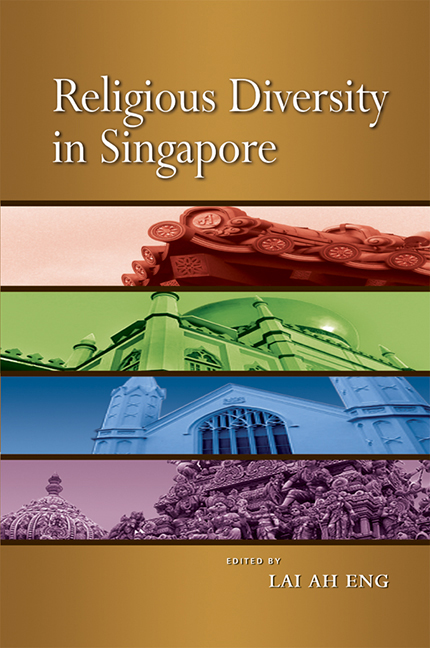Book contents
- Frontmatter
- Contents
- List of Figures and Tables
- List of Appendices
- FOREWORD
- PREFACE
- Acknowledgements
- The Contributors
- Abbreviations
- Glossary
- INTRODUCTION
- PART I The Landscape of Religious Diversity
- PART II Religion in Schools and Among the Young
- PART III Religion in the Media
- PART IV Religious Organizations in Social Services
- PART V Interfaith Issues and Interaction
- 23 Religious Diversity, Toleration and Interaction
- 24 Negotiating Christianity with Other Religions: The Views of Christian Clergymen in Singapore
- 25 The Inter-Religious Organization of Singapore
- 26 Interactions among Youth Leaders of Different Faiths: Realities from the Ground and Lessons Learnt
- 27 Building Bridges between Christians and Muslims: A Personal Journey
- 28 Conclusion: Some Remarks on Religious Diversity in Singapore
- Index
26 - Interactions among Youth Leaders of Different Faiths: Realities from the Ground and Lessons Learnt
from PART V - Interfaith Issues and Interaction
Published online by Cambridge University Press: 21 October 2015
- Frontmatter
- Contents
- List of Figures and Tables
- List of Appendices
- FOREWORD
- PREFACE
- Acknowledgements
- The Contributors
- Abbreviations
- Glossary
- INTRODUCTION
- PART I The Landscape of Religious Diversity
- PART II Religion in Schools and Among the Young
- PART III Religion in the Media
- PART IV Religious Organizations in Social Services
- PART V Interfaith Issues and Interaction
- 23 Religious Diversity, Toleration and Interaction
- 24 Negotiating Christianity with Other Religions: The Views of Christian Clergymen in Singapore
- 25 The Inter-Religious Organization of Singapore
- 26 Interactions among Youth Leaders of Different Faiths: Realities from the Ground and Lessons Learnt
- 27 Building Bridges between Christians and Muslims: A Personal Journey
- 28 Conclusion: Some Remarks on Religious Diversity in Singapore
- Index
Summary
INTRODUCTION
The post 9/11 rise of global terrorism has raised the awareness and the potential social threat of religious extremism. Battling such terrorism headon results in a tragic scenario of “violence begets violence”. Conflicts like terrorism require bottom-up approaches and solutions. Interfaith youth engagement is one such approach. It potentially educates youths from different faiths on their commonality. Only by such gradual education can interfaith understanding advance beyond mere tolerance into true respect from understanding. Mere tolerance can be quite fragile in the face of social mistrust resulting from terrorism.
On the social cohesion front, Singapore's forty years of nation-building has been based on a contract of mutual tolerance between the different faiths and racial communities, with the government as a paternal moderator. However, in the face of rapid globalization, the rapid spread of diverse ideas through info-communication technology and changing global politicosocial dynamics have made it necessary to re-examine the current social contract of interfaith engagements, particularly those amongst youths. Preparations must be made for youths to inherit the responsibility of upholding multiracial and multi-religious respect, and to continue and advance effective interfaith engagement. This chapter examines the ground realities of interfaith youth engagement and suggests policy recommendations, including social actions that will equip all stakeholders to move from mutual tolerance to a coherent and in-depth interfaith engagement, thereby strengthening social cohesion.
What is Interfaith?
Due to its sensitivity and tendency for misunderstandings, it is worthwhile to define the intended scope and role of “interfaith” in Singapore. Interfaith is not about uniting faiths to form a universal religion. Rather, as the prefix “inter” implies, it involves an understanding amongst different religions of their common social purposes. In Singapore, faith and ethnicity can be highly intertwined. By induction therefore, multiracial and interfaith harmony enjoy a parallel relationship with each other. In context, they are thus vital elements of Singapore's nation-building. In this study, the terms “faith” and “religion” are understood as synonymous and will be used interchangeably.
Currently, the consensual and official direction of interfaith harmony, as spelt out under the Declaration on Religious Harmony (2003), lies in achieving religious harmony through “mutual tolerance, confidence, respect and understanding”.
- Type
- Chapter
- Information
- Religious Diversity in Singapore , pp. 642 - 667Publisher: ISEAS–Yusof Ishak InstitutePrint publication year: 2008

